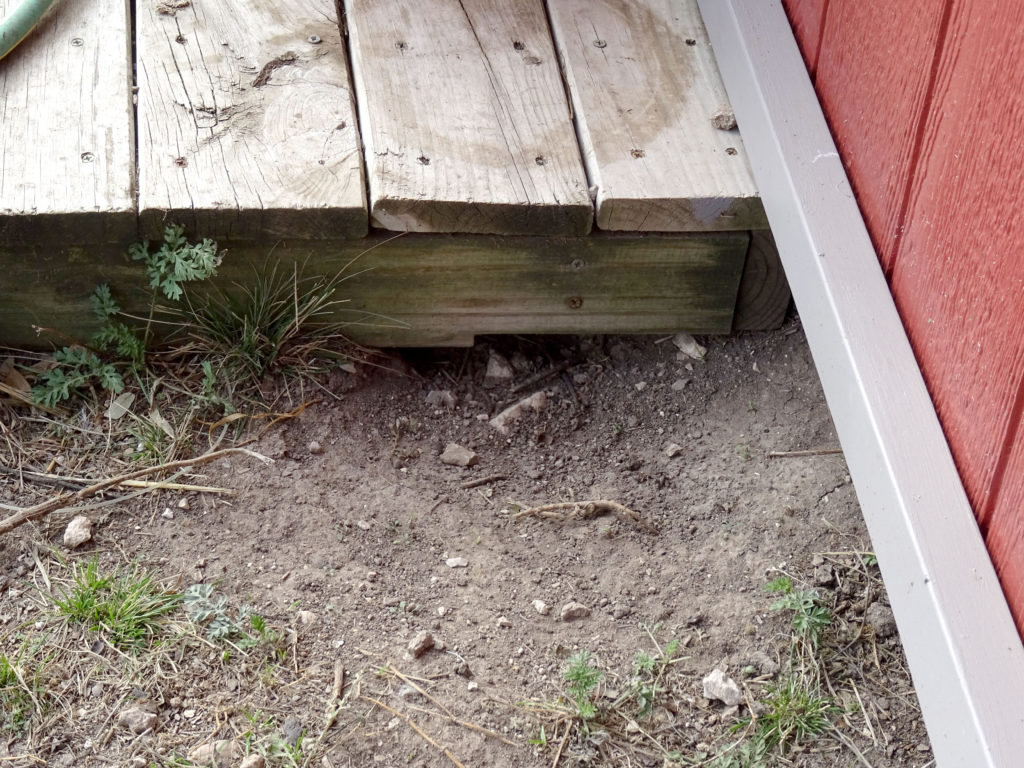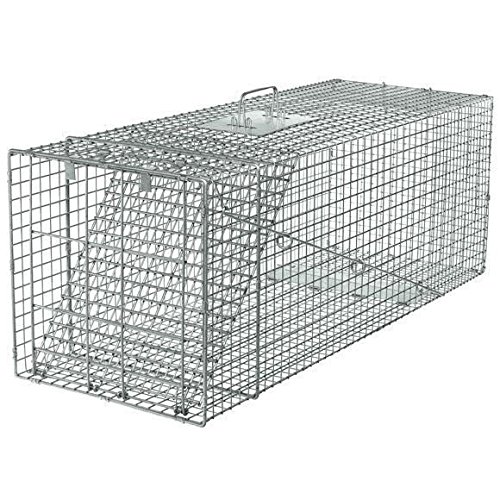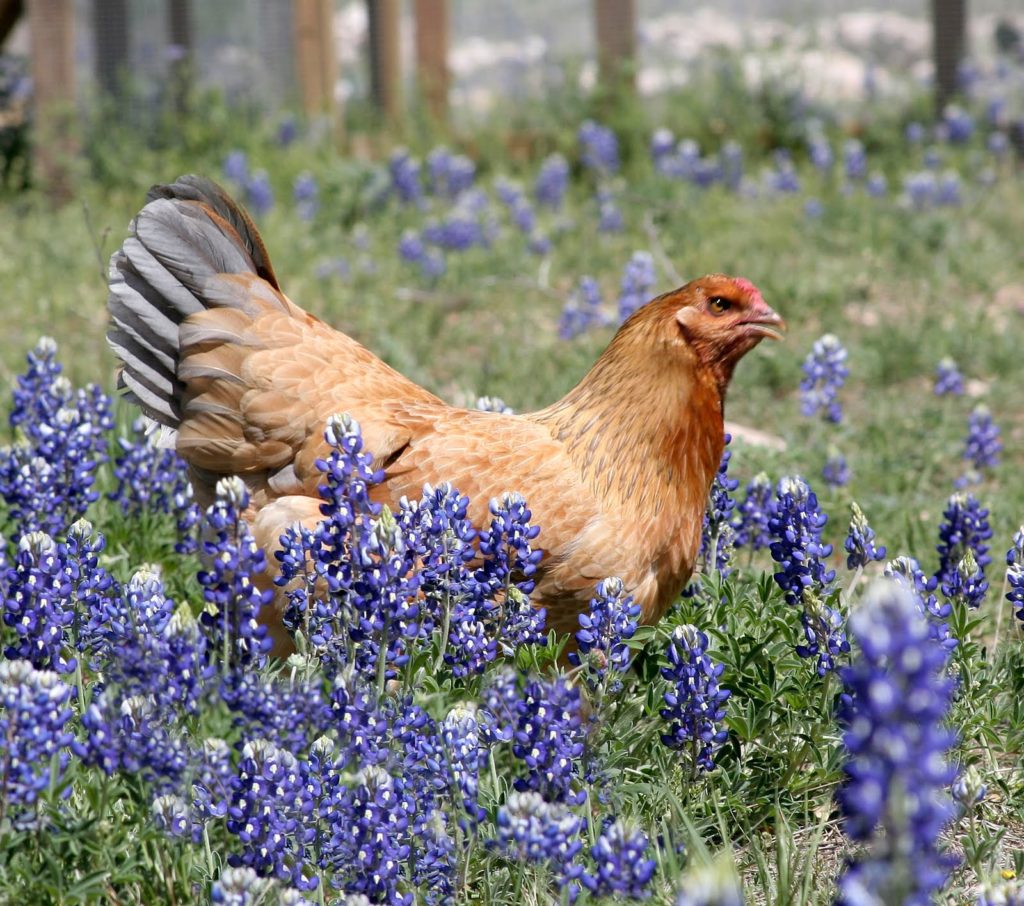If you are going to raise chickens, sooner or later you are going to have to deal with the issue of predators. If you are not willing to deal with this issue, you should not try to raise chickens. What we have found that works best is to have a layered approach, where we have layer upon layer upon layer of protection for our birds. With this layered approach, we rarely loose a chicken to predators. When we do lose a chicken, it is usually because we have grown lazy, and not followed the procedures outlined below. I hope you find these techniques helpful, and hope they encourage you to do your best to protect your flock. Do not be discouraged if you can not do everything we outline below. Do your best to do as much as you can of each technique, and realize that any protection is better than no protection, even if you can not implement as much as we have below.
The first step in protecting your flock is to secure your perimeter. That is, your property should have a good fence. Never purchase more property than what you can afford to fence. Our homestead is 10 acres, and I found that fencing the property was expensive. Fencing was half again what I had paid for the property.
A good fence is not just an important step in protecting your birds, it is also critical to almost all aspects of prepping and homesteading. if you plan on raising a garden or an orchard, you will want to keep deer off your property. A few deer can devastate a garden and kill an orchard in a single night. During certain times of the year, deer begin to have their antlers itch, and they then go and scrape them on trees. This quickly rubs the bark off, and kills the trees. Several deer can wipe out an orchard in a single night scraping their antlers on the trees. A good perimeter fence should be designed to keep deer out and to keep predators out. In designing your fence, you should think about both two legged and four legged predators. The two legged variety will be the topic of a future article. Today, we will just look at the four legged variety, also known as varmints.

It is almost impossible to create an impenetrable outer perimeter to varmints, so in putting up a fence, you should look at it as your first line of defense, not your only line of defense. The goal of the perimeter fence is to just make it easier for a predator to go somewhere else. Since we wanted to keep deer and varmints out, we decided to build an 8 foot deer fence with barbed wire at the top. We chose “no-climb” fencing which has tightly spaced (about 2 inch) wire mesh. Larger mesh is transparent to varmints, as they can walk right through it. The smaller wire mesh creates a barrier that varmints will not be able to walk through. The tight wire mesh spacing, and the barbed wire strands on top also make it uninviting to two legged predators. Again, it is not intended to be impenetrable, but just sends a message that it might be easier to rob someone else’s house than ours.

In creating an outer perimeter to keep varmints out, you must pay careful attention to the property gate. Make sure you do not create an easy opening for varmints to gain access to your property. The gate material should not have any large holes, and the spacing between the gate, ground, and fence should be small. The picture above shows our property gate. Notice that there are no gaps large enough for a varmint to enter.
Again, remember that I am describing a layered approach to protecting your chickens. Do not become discouraged if you can not create a perimeter as secure as the one I show above. Do the best you can with the resources you have.
So the first step in protecting your chickens is to secure your perimeter with a good fence. The next layer of protection is to patrol your perimeter, and to look for signs of predators entering your property. Even with a secure fence, predators will tunnel under your fence. When you find signs of predators coming under your fence, plug the trails and tunnels with rocks. Use big rocks, and sharp jagged rocks if possible. Make your property uninviting for predators.
Patrolling my perimeter today, I found a number of places varmints are coming under the fence, and I plugged up these holes with large rocks.

When plugging areas predators are coming under your fence, use big rocks, lots of rocks and jagged rocks if you have them. Make it an uninviting site for predators.

So the first line of defense is to secure your perimeter with a good fence, and then to patrol the perimeter and plug any places that animals are coming under the fence. The next layer of protection is to clean and clear your property to remover habitat for predators. Predators love thickets, bushes, rock piles and such. As best you can keep your property clean and clear. You want habitat for grazing animals, for chicken, for gardens and orchards, not a wild bramble for varmints to hide in. When I purchased my property, it was covered with cactus and sticker bushes. Over time I have cleared it where now I have native trees and grasslands. It was a lot of work, but that is what homesteading is all about . . . constantly improving the property.

Varmints are reclusive by nature and big open grasslands are not an attractive home for them. You can see in the picture above, the property is not very inviting to those looking for brambles and thickets to hide in.
In addition to removing thickets and rock piles, you should also look for areas that would be inviting for varmints to burrow in and spend the winter. Barns are old storage sheds are very inviting places for predators.

In the picture above you can see an animal has dug under the porch on a small storage building on my property. He probably intends to spend the winter there. This building is close to my chicken coops, and If I do not address this he doubtless will start snagging chickens out of the barnyard.
You must be diligent to keep your eyes open for any area that predators might be burrowing in on your property for winter.
Besides looking for areas that varmints are burrowing in on your property, you must also constantly be looking for other signs that unwanted guests are taking up residency on your property. One of the clearest signs is varmint “scat”, more commonly called poop.
Predators will usually use their poop to mark their territory, so they often poop in very conspicuous places, like in the middle of the road on top of a rock. When you see the first sign of predator poop, you must immediately take action to eliminate the predator, or he will begin to take your chickens. It is fairly easy to identify varmint poop. You know what dog poop looks like and you know what cat poop looks like. Well, varmint poop is different than that. It typically is much less uniform and shows indications that the animal is a scavenger. Lots of seeds, and other irregularities.

At the first sign of varmint poop, you must take immediate action to eliminate the varmint or you are going to lose your chickens. I found this poop several days ago on our property and recognized it as skunk poop. I put out my large live trap and baited it with sardines. I like the following live trap as it is large enough for any varmint, it is secure and is easy to use and effective. I recommend the Havahart 1081 Live Trap which can be ordered HERE.

Before setting the live trap, be sure to think things completely through. First, is it legal in your area to trap the animal that you are after. Next, what will you do with the animal once you catch it. Is there a remote place that you can legally release it? Is there an animal control officer that you can take the animal to? Can you legally and safely kill the animal yourself when you catch it?

Similar to skunk poop, Raccoon poop is very distinctive and hard to miss.

if you find raccoon poop you must take immediate action to protect your flock. After finding the raccoon poop above, I caught the predator using the Coon Cuff trap available HERE. If you purchase the coon cuff, I suggest you also get the setting tool. The trap is hard to set without the tool. I baited the coon cuff with marshmallows, which raccoons seem to find irresistible.
I prefer using the live trap over the coon cuff. However, the raccoons often travel and live as families, and once one becomes trapped in the live trap, the other ones can become fearful of it. Hence, we sometimes need multiple tools in our arsenal to deal with the predator problem.
For me I view my primary responsibility is to protect my flock. I am not out looking for trouble and make my property as uninviting to predators as possible. But if one comes onto my property my main job is to protect the chickens. Hence, since it is safe and legal for me to kill predators in my area, when I capture a predator in the live trap, I kill it as humanely as I can. For me, this means shooting it with a small 22 pistol.
The live trap will work for most predators except the fox. I have found fox to be much too cunning and perceptive to get caught in a trap. In fact, even though I have trapped professional, I have never been able to trap a fox. For fox, I use a call, lure the fox in with a call, and then shoot it. This is not something I recommend for the novice. If you are dealing with a fox see if you can call in a professional, or an old sage in your area adept at dealing with fox. Also make sure you pursue elimination of the fox in a way that is legal and safe in your area. For me, a fox call, spotlight and 22 rifle have been the preferred method of dealing with fox.


The final level of protection for your chickens is the chicken coop. You need to make your coop and chicken run impenetrable to varmints. Remember that raccoons have thumbs so they can unlatch just about anything you can latch. Raccoons are very smart, and very adept at opening things. In addition, raccoons can crawl through very small gaps. So, you must ensure that your coop is completely secure, and that latches are strong enough that the raccoon can not open them. I use latches with a carabiner to secure the doors on the coop. I have found that raccoons so far have not been able to figure out the carabiner.
You must realize that varmints are very adept diggers. The chicken run should be secured on all sides with hail screen. I prefer hail screen over chicken wire because it is more secure. I have heard of coons tearing through chicken wiring. Remember in particular that the chicken run should have hail screen on the bottom. Varmints can easily dig under the chicken run fence. Protect your birds by covering the bottom of the run with hail screen.
Instinctively, chickens know to go into their coops at dusk. What is critical is for you to close them up as soon as they go in. Varmints come out at dark fall. You have a small window to close the chickens before the varmints will be coming out. Many times when disaster hits it is because the owner was distracted and did not get the chicken coop closed on time. Being diligent to close the chickens before it gets dark, and to let them out after it is light, and to make sure the coop is completely secure will go a long way in protecting your chickens in most circumstance.

I hope you have found this article useful. Again, this strategy is a layered strategy, and do not be discouraged if you can not do all the things I have shown. If nothing else, if you can have a secure coop and be diligent to close it as soon as the chickens are in, you will be in pretty good shape.
